
The remarkable twin Voyager spacecraft continue to explore the outer reaches of the solar system decades after they completed their surveys of the Outer Planets. Launched in 1977 (September 5 for Voyager 1 (V1) and August 20 for Voyager 2 (V2), whose trajectory took it past Jupiter after Voyager 1), the spacecraft pair made many fundamental discoveries as they flew past Jupiter (March 1979 for V1, July 1979 for V2) and Saturn (November 1980 for V1, August 1981 for V2). The path of Voyager 2 past Saturn was targeted so that it continued within the plane of the solar system, allowing it to become the first spacecraft to visit Uranus (January 1986) and Neptune (August 1989). Following the Neptune encounter, both spacecraft started a new phase of exploration under the intriguing title of the Voyager Interstellar Mission.
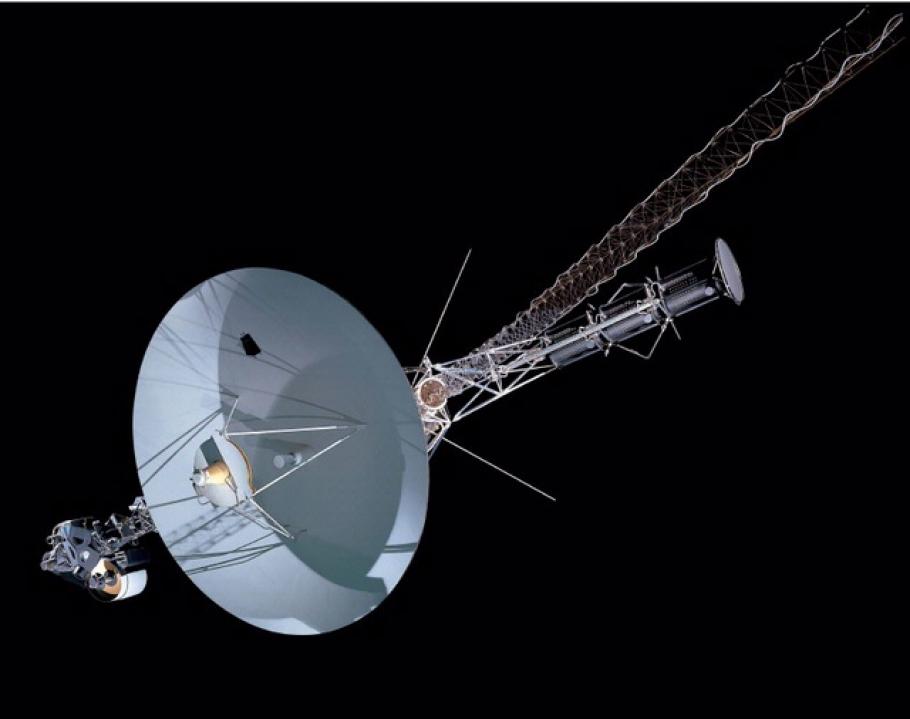
Five instruments continue to collect important measurements of magnetic fields, plasmas, and charged particles as both spacecraft explore different portions of the solar system beyond the orbits of the planets. Voyager 1 is now more than 118 astronomical units (one AU is equal to the average orbital distance of Earth from the Sun) distant from the sun, traveling at a speed (relative to the sun) of 17.1 kilometers per second (10.6 miles per second). Voyager 2 is now more than 96 AU from the sun, traveling at a speed of 15.5 kilometers per second (9.6 miles per second). Both spacecraft are moving considerably faster than Pioneers 10 and 11, two earlier spacecraft that became the first robotic visitors to fly past Jupiter and Saturn in the mid-70s.
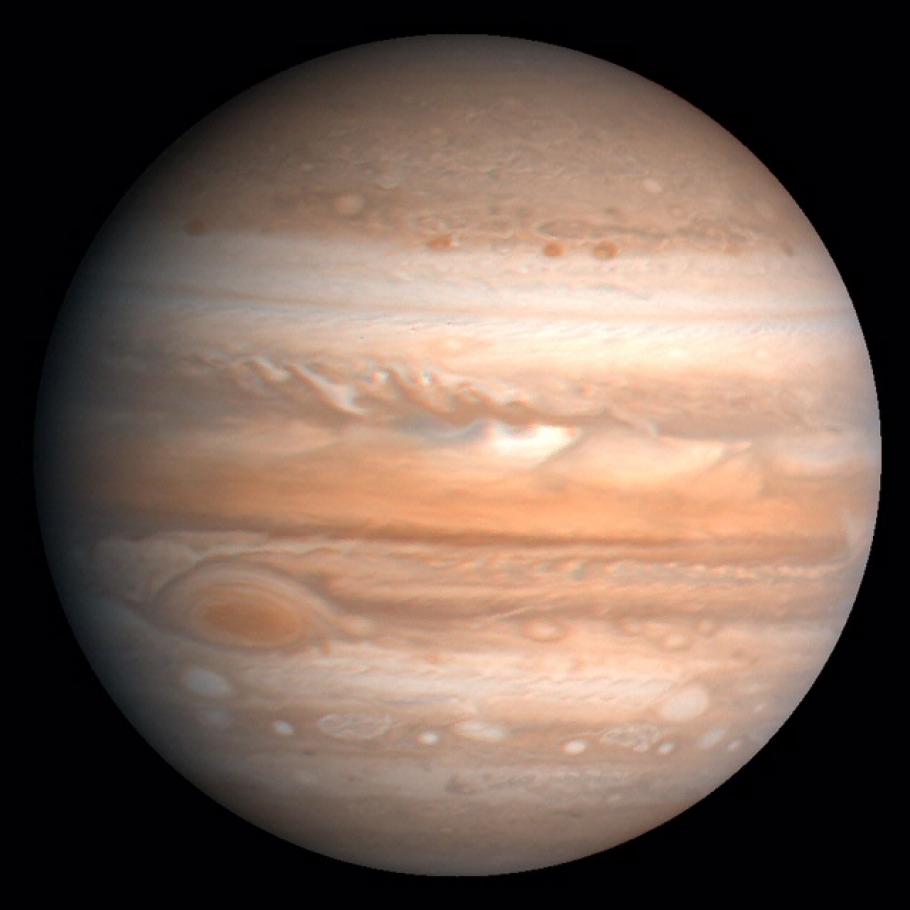
This processed color image of Jupiter was produced in 1990 by the U.S. Geological Survey from a Voyager image captured in 1979. The colors have been enhanced to bring out detail. Zones of light-colored, ascending clouds alternate with bands of dark, descending clouds. The clouds travel around the planet in alternating eastward and westward belts at speeds of up to 540 kilometers per hour. Tremendous storms as big as Earthly continents surge around the planet. The Great Red Spot (oval shape toward the lower-left) is an enormous anticyclonic storm that drifts along its belt, eventually circling the entire planet.
As seen in the night sky at Earth, Voyager 1 is within the confines of the constellation Ophiuchus, only slightly above the celestial equator; no telescope can see it, but radio contact is expected to be maintained for at least the next ten years. Voyager 2 is within the bounds of the constellation Telescopium (which somehow sounds quite appropriate) in the far southern night sky.
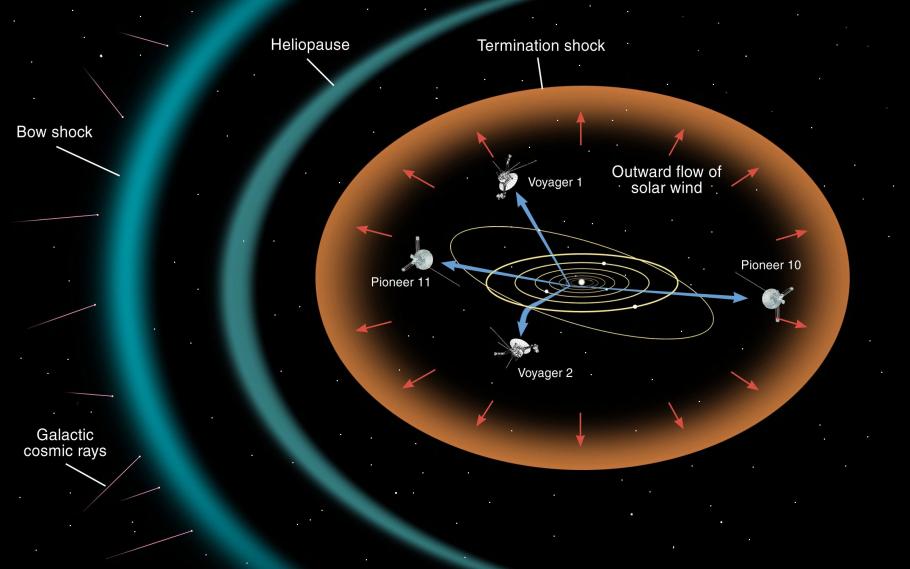
Both spacecraft have already passed something called the Termination Shock † (December 2004 for V1, August 2007 for V2), where the solar wind slows as it starts to interact with the particles and fields present between the stars. It is expected that both spacecraft will encounter the Heliopause, where the solar wind ceases as true interstellar space begins, from 10 to 20 years after crossing the Termination Shock. Theories exist for what should be present in interstellar space, but the Voyagers will become the first man-made objects to go beyond the influences of the Sun, hopefully returning the first measurements of what it is like out there. Each spacecraft is carrying a metal record with encoded sounds and sights from Earth, along with the needle needed to read the recordings, and simplified instructions for where the spacecraft came from, in case they are eventually discovered by intelligent extra-terrestrials.
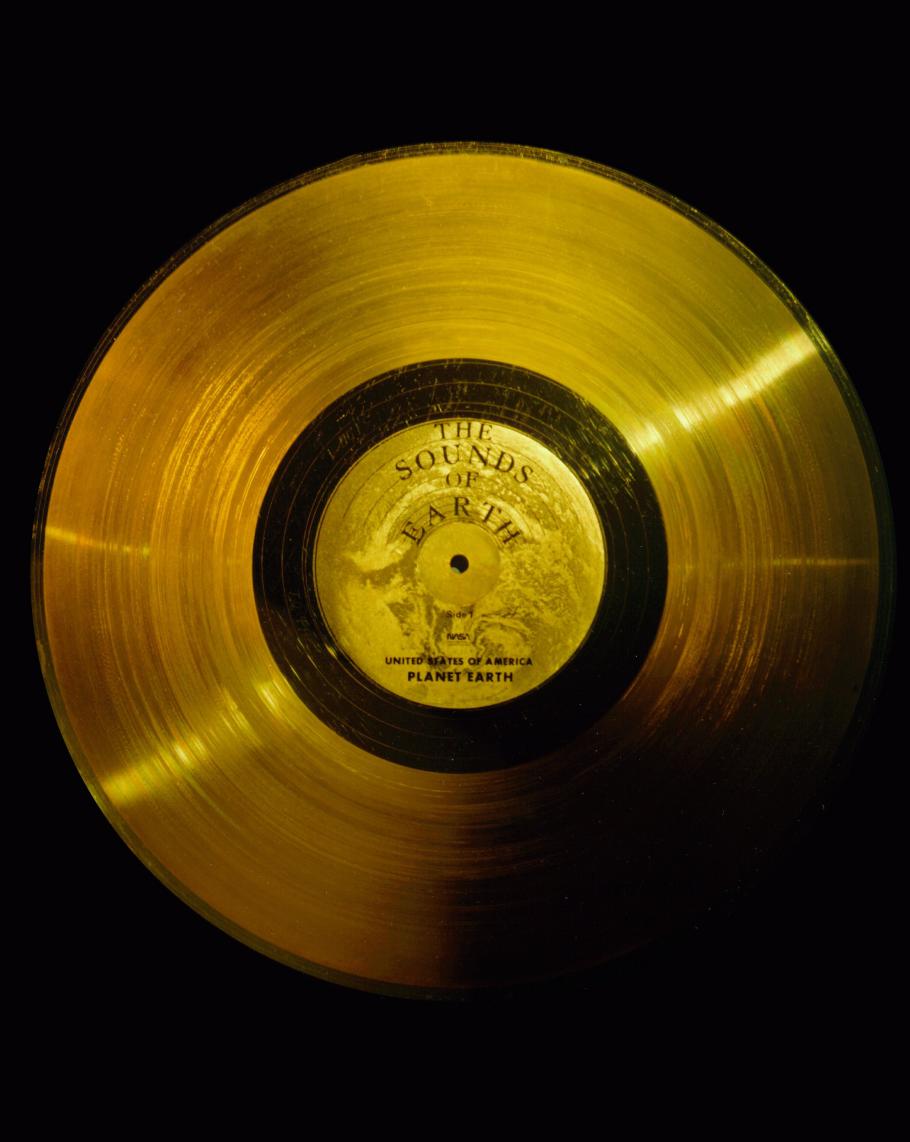
Keep track of the Voyager spacecraft on the official Voyager Interstellar Mission website or follow @NASAVoyager2 on Twitter. † The sun ejects a continuous stream of charged particles (electrons, protons, etc) that is collectively termed the solar wind. The particles are traveling extremely fast and are dense enough to form a very tenuous atmosphere; the heliosphere represents the volume of space where the effects of the solar wind dominate over those of particles in interstellar space. The solar wind particles are moving very much faster than the local speed of sound represented by their low volume density. When the particles begin to interact with interstellar particles and fields (the interaction can be either physically running into other particles or experiencing an electromagnetic force resulting from a charged particle moving within a magnetic field), then they start to slow down. The point at which they become subsonic (rather than their normal hypersonic speed) is the Termination Shock.
We rely on the generous support of donors, sponsors, members, and other benefactors to share the history and impact of aviation and spaceflight, educate the public, and inspire future generations. With your help, we can continue to preserve and safeguard the world’s most comprehensive collection of artifacts representing the great achievements of flight and space exploration.
- Get Involved
- Host an Event

Thank you. You have successfully signed up for our newsletter.
Error message, sorry, there was a problem. please ensure your details are valid and try again..
- Free Timed-Entry Passes Required
- Terms of Use
- Mobile Site
- Staff Directory
- Advertise with Ars
Filter by topic
- Biz & IT
- Gaming & Culture
Front page layout
Some hope —
Finally, engineers have a clue that could help them save voyager 1, a new signal from humanity's most distant spacecraft could be the key to restoring it..
Stephen Clark - Mar 15, 2024 11:23 pm UTC
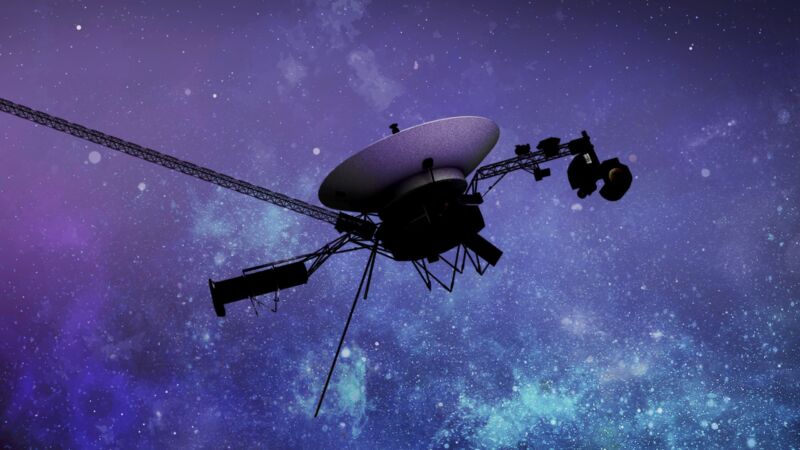
It's been four months since NASA's Voyager 1 spacecraft sent an intelligible signal back to Earth, and the problem has puzzled engineers tasked with supervising the probe exploring interstellar space.
But there's a renewed optimism among the Voyager ground team based at NASA's Jet Propulsion Laboratory in California. On March 1, engineers sent a command up to Voyager 1—more than 15 billion miles (24 billion kilometers) away from Earth—to "gently prompt" one of the spacecraft's computers to try different sequences in its software package. This was the latest step in NASA's long-distance troubleshooting to try to isolate the cause of the problem preventing Voyager 1 from transmitting coherent telemetry data.
Cracking the case
Officials suspect a piece of corrupted memory inside the Flight Data Subsystem (FDS), one of three main computers on the spacecraft, is the most likely culprit for the interruption in normal communication. Because Voyager 1 is so far away, it takes about 45 hours for engineers on the ground to know how the spacecraft reacted to their commands—the one-way light travel time is about 22.5 hours.
The FDS collects science and engineering data from the spacecraft's sensors, then combines the information into a single data package, which goes through a separate component called the Telemetry Modulation Unit to beam it back to Earth through Voyager's high-gain antenna.
Engineers are almost entirely certain the problem is in the FDS computer. The communications systems onboard Voyager 1 appear to be functioning normally, and the spacecraft is sending a steady radio tone back to Earth, but there's no usable data contained in the signal. This means engineers know Voyager 1 is alive, but they have no insight into what part of the FDS memory is causing the problem.
But Voyager 1 responded to the March 1 troubleshooting command with something different from what engineers have seen since this issue first appeared on November 14.
"The new signal was still not in the format used by Voyager 1 when the FDS is working properly, so the team wasn’t initially sure what to make of it," NASA said in an update Wednesday. "But an engineer with the agency’s Deep Space Network, which operates the radio antennas that communicate with both Voyagers and other spacecraft traveling to the Moon and beyond, was able to decode the new signal and found that it contains a readout of the entire FDS memory."
Now, engineers are meticulously comparing each bit of code from the FDS memory readout to the memory readout Voyager 1 sent back to Earth before the issue arose in November. This, they hope, will allow them to find the root of the problem. But it will probably take weeks or months for the Voyager team to take the next step. They don't want to cause more harm.
"Using that information to devise a potential solution and attempt to put it into action will take time," NASA said.
This is perhaps the most serious ailment the spacecraft has encountered since its launch in 1977. Voyager 1 flew by Jupiter and Saturn before getting a kick from Saturn's gravity to speed into the outer solar system. In 2012, Voyager 1 entered interstellar space when it crossed the heliopause, where the solar wind, the stream of particles emanating from the Sun, push against a so-called galactic wind, the particles that populate the void between the stars.
Engineers have kept Voyager 1 and its twin, Voyager 2, alive for more than 46 years , overcoming technical problems that have doomed other space missions. Both probes face waning power from their nuclear batteries, and there are concerns about their thrusters aging and fuel lines becoming clogged, among other things. But each time there is a problem, ground teams have come up with a trick to keep the Voyagers going, often referencing binders of fraying blueprints and engineering documents from the spacecraft's design and construction nearly 50 years ago.
Suzanne Dodd, NASA's project manager for Voyager 1 and its twin, Voyager 2, recently told Ars that engineers would need to pull off their "biggest miracle" to restore Voyager 1 to normal operations. Now, Voyager 1's voice from the sky has provided engineers with a clue that could help them realize this miracle.
reader comments
Channel ars technica.
- Share full article
Advertisement
Supported by
Voyager 1, First Craft in Interstellar Space, May Have Gone Dark
The 46-year-old probe, which flew by Jupiter and Saturn in its youth and inspired earthlings with images of the planet as a “Pale Blue Dot,” hasn’t sent usable data from interstellar space in months.

By Orlando Mayorquin
When Voyager 1 launched in 1977, scientists hoped it could do what it was built to do and take up-close images of Jupiter and Saturn. It did that — and much more.
Voyager 1 discovered active volcanoes, moons and planetary rings, proving along the way that Earth and all of humanity could be squished into a single pixel in a photograph, a “ pale blue dot, ” as the astronomer Carl Sagan called it. It stretched a four-year mission into the present day, embarking on the deepest journey ever into space.
Now, it may have bid its final farewell to that faraway dot.
Voyager 1 , the farthest man-made object in space, hasn’t sent coherent data to Earth since November. NASA has been trying to diagnose what the Voyager mission’s project manager, Suzanne Dodd, called the “most serious issue” the robotic probe has faced since she took the job in 2010.
The spacecraft encountered a glitch in one of its computers that has eliminated its ability to send engineering and science data back to Earth.
The loss of Voyager 1 would cap decades of scientific breakthroughs and signal the beginning of the end for a mission that has given shape to humanity’s most distant ambition and inspired generations to look to the skies.
“Scientifically, it’s a big loss,” Ms. Dodd said. “I think — emotionally — it’s maybe even a bigger loss.”
Voyager 1 is one half of the Voyager mission. It has a twin spacecraft, Voyager 2.
Launched in 1977, they were primarily built for a four-year trip to Jupiter and Saturn , expanding on earlier flybys by the Pioneer 10 and 11 probes.
The Voyager mission capitalized on a rare alignment of the outer planets — once every 175 years — allowing the probes to visit all four.
Using the gravity of each planet, the Voyager spacecraft could swing onto the next, according to NASA .
The mission to Jupiter and Saturn was a success.
The 1980s flybys yielded several new discoveries, including new insights about the so-called great red spot on Jupiter, the rings around Saturn and the many moons of each planet.
Voyager 2 also explored Uranus and Neptune , becoming in 1989 the only spacecraft to explore all four outer planets.

Voyager 1, meanwhile, had set a course for deep space, using its camera to photograph the planets it was leaving behind along the way. Voyager 2 would later begin its own trek into deep space.
“Anybody who is interested in space is interested in the things Voyager discovered about the outer planets and their moons,” said Kate Howells, the public education specialist at the Planetary Society, an organization co-founded by Dr. Sagan to promote space exploration.
“But I think the pale blue dot was one of those things that was sort of more poetic and touching,” she added.
On Valentine’s Day 1990, Voyager 1, darting 3.7 billion miles away from the sun toward the outer reaches of the solar system, turned around and snapped a photo of Earth that Dr. Sagan and others understood to be a humbling self-portrait of humanity.
“It’s known the world over, and it does connect humanity to the stars,” Ms. Dodd said of the mission.
She added: “I’ve had many, many many people come up to me and say: ‘Wow, I love Voyager. It’s what got me excited about space. It’s what got me thinking about our place here on Earth and what that means.’”
Ms. Howells, 35, counts herself among those people.
About 10 years ago, to celebrate the beginning of her space career, Ms. Howells spent her first paycheck from the Planetary Society to get a Voyager tattoo.
Though spacecraft “all kind of look the same,” she said, more people recognize the tattoo than she anticipated.
“I think that speaks to how famous Voyager is,” she said.
The Voyagers made their mark on popular culture , inspiring a highly intelligent “Voyager 6” in “Star Trek: The Motion Picture” and references on “The X Files” and “The West Wing.”
Even as more advanced probes were launched from Earth, Voyager 1 continued to reliably enrich our understanding of space.
In 2012, it became the first man-made object to exit the heliosphere, the space around the solar system directly influenced by the sun. There is a technical debate among scientists around whether Voyager 1 has actually left the solar system, but, nonetheless, it became interstellar — traversing the space between stars.
That charted a new path for heliophysics, which looks at how the sun influences the space around it. In 2018, Voyager 2 followed its twin between the stars.
Before Voyager 1, scientific data on the sun’s gases and material came only from within the heliosphere’s confines, according to Dr. Jamie Rankin, Voyager’s deputy project scientist.
“And so now we can for the first time kind of connect the inside-out view from the outside-in,” Dr. Rankin said, “That’s a big part of it,” she added. “But the other half is simply that a lot of this material can’t be measured any other way than sending a spacecraft out there.”
Voyager 1 and 2 are the only such spacecraft. Before it went offline, Voyager 1 had been studying an anomalous disturbance in the magnetic field and plasma particles in interstellar space.
“Nothing else is getting launched to go out there,” Ms. Dodd said. “So that’s why we’re spending the time and being careful about trying to recover this spacecraft — because the science is so valuable.”
But recovery means getting under the hood of an aging spacecraft more than 15 billion miles away, equipped with the technology of yesteryear. It takes 45 hours to exchange information with the craft.
It has been repeated over the years that a smartphone has hundreds of thousands of times Voyager 1’s memory — and that the radio transmitter emits as many watts as a refrigerator lightbulb.
“There was one analogy given that is it’s like trying to figure out where your cursor is on your laptop screen when your laptop screen doesn’t work,” Ms. Dodd said.
Her team is still holding out hope, she said, especially as the tantalizing 50th launch anniversary in 2027 approaches. Voyager 1 has survived glitches before, though none as serious.
Voyager 2 is still operational, but aging. It has faced its own technical difficulties too.
NASA had already estimated that the nuclear-powered generators of both spacecrafts would likely die around 2025.
Even if the Voyager interstellar mission is near its end, the voyage still has far to go.
Voyager 1 and its twin, each 40,000 years away from the next closest star, will arguably remain on an indefinite mission.
“If Voyager should sometime in its distant future encounter beings from some other civilization in space, it bears a message,” Dr. Sagan said in a 1980 interview .
Each spacecraft carries a gold-plated phonograph record loaded with an array of sound recordings and images representing humanity’s richness, its diverse cultures and life on Earth.
“A gift across the cosmic ocean from one island of civilization to another,” Dr. Sagan said.
Orlando Mayorquin is a general assignment and breaking news reporter based in New York. More about Orlando Mayorquin
What’s Up in Space and Astronomy
Keep track of things going on in our solar system and all around the universe..
Never miss an eclipse, a meteor shower, a rocket launch or any other 2024 event that’s out of this world with our space and astronomy calendar .
A new set of computer simulations, which take into account the effects of stars moving past our solar system, has effectively made it harder to predict Earth’s future and reconstruct its past.
Dante Lauretta, the planetary scientist who led the OSIRIS-REx mission to retrieve a handful of space dust , discusses his next final frontier.
A nova named T Coronae Borealis lit up the night about 80 years ago. Astronomers say it’s expected to put on another show in the coming months.
Voyager 1, the 46-year-old first craft in interstellar space which flew by Jupiter and Saturn in its youth, may have gone dark .
Is Pluto a planet? And what is a planet, anyway? Test your knowledge here .
- Skip to main content
- Keyboard shortcuts for audio player
NASA's Voyager 1 spacecraft is talking nonsense. Its friends on Earth are worried

Nell Greenfieldboyce

This artist's impression shows one of the Voyager spacecraft moving through the darkness of space. NASA/JPL-Caltech hide caption
This artist's impression shows one of the Voyager spacecraft moving through the darkness of space.
The last time Stamatios "Tom" Krimigis saw the Voyager 1 space probe in person, it was the summer of 1977, just before it launched from Cape Canaveral, Florida.
Now Voyager 1 is over 15 billion miles away, beyond what many consider to be the edge of the solar system. Yet the on-board instrument Krimigis is in charge of is still going strong.
"I am the most surprised person in the world," says Krimigis — after all, the spacecraft's original mission to Jupiter and Saturn was only supposed to last about four years.
These days, though, he's also feeling another emotion when he thinks of Voyager 1.
"Frankly, I'm very worried," he says.
Ever since mid-November, the Voyager 1 spacecraft has been sending messages back to Earth that don't make any sense. It's as if the aging spacecraft has suffered some kind of stroke that's interfering with its ability to speak.
"It basically stopped talking to us in a coherent manner," says Suzanne Dodd of NASA's Jet Propulsion Laboratory, who has been the project manager for the Voyager interstellar mission since 2010. "It's a serious problem."
Instead of sending messages home in binary code, Voyager 1 is now just sending back alternating 1s and 0s. Dodd's team has tried the usual tricks to reset things — with no luck.
It looks like there's a problem with the onboard computer that takes data and packages it up to send back home. All of this computer technology is primitive compared to, say, the key fob that unlocks your car, says Dodd.
"The button you press to open the door of your car, that has more compute power than the Voyager spacecrafts do," she says. "It's remarkable that they keep flying, and that they've flown for 46-plus years."

Each of the Voyager probes carries an American flag and a copy of a golden record that can play greetings in many languages. NASA/JPL-Caltech hide caption
Each of the Voyager probes carries an American flag and a copy of a golden record that can play greetings in many languages.
Voyager 1 and its twin, Voyager 2, have outlasted many of those who designed and built them. So to try to fix Voyager 1's current woes, the dozen or so people on Dodd's team have had to pore over yellowed documents and old mimeographs.
"They're doing a lot of work to try and get into the heads of the original developers and figure out why they designed something the way they did and what we could possibly try that might give us some answers to what's going wrong with the spacecraft," says Dodd.
She says that they do have a list of possible fixes. As time goes on, they'll likely start sending commands to Voyager 1 that are more bold and risky.
"The things that we will do going forward are probably more challenging in the sense that you can't tell exactly if it's going to execute correctly — or if you're going to maybe do something you didn't want to do, inadvertently," says Dodd.
Linda Spilker , who serves as the Voyager mission's project scientist at NASA's Jet Propulsion Laboratory, says that when she comes to work she sees "all of these circuit diagrams up on the wall with sticky notes attached. And these people are just having a great time trying to troubleshoot, you know, the 60's and 70's technology."
"I'm cautiously optimistic," she says. "There's a lot of creativity there."
Still, this is a painstaking process that could take weeks, or even months. Voyager 1 is so distant, it takes almost a whole day for a signal to travel out there, and then a whole day for its response to return.
"We'll keep trying," says Dodd, "and it won't be quick."
In the meantime, Voyager's 1 discombobulation is a bummer for researchers like Stella Ocker , an astronomer with Caltech and the Carnegie Observatories
"We haven't been getting science data since this anomaly started," says Ocker, "and what that means is that we don't know what the environment that the spacecraft is traveling through looks like."

After 35 Years, Voyager Nears Edge Of Solar System
That interstellar environment isn't just empty darkness, she says. It contains stuff like gas, dust, and cosmic rays. Only the twin Voyager probes are far out enough to sample this cosmic stew.
"The science that I'm really interested in doing is actually only possible with Voyager 1," says Ocker, because Voyager 2 — despite being generally healthy for its advanced age — can't take the particular measurements she needs for her research.
Even if NASA's experts and consultants somehow come up with a miraculous plan that can get Voyager 1 back to normal, its time is running out.
The two Voyager probes are powered by plutonium, but that power system will eventually run out of juice. Mission managers have turned off heaters and taken other measures to conserve power and extend the Voyager probes' lifespan.
"My motto for a long time was 50 years or bust," says Krimigis with a laugh, "but we're sort of approaching that."
In a couple of years, the ebbing power supply will force managers to start turning off science instruments, one by one. The very last instrument might keep going until around 2030 or so.
When the power runs out and the probes are lifeless, Krimigis says both of these legendary space probes will basically become "space junk."
"It pains me to say that," he says. While Krimigis has participated in space missions to every planet, he says the Voyager program has a special place in his heart.
Spilker points out that each spacecraft will keep moving outward, carrying its copy of a golden record that has recorded greetings in many languages, along with the sounds of Earth.
"The science mission will end. But a part of Voyager and a part of us will continue on in the space between the stars," says Spilker, noting that the golden records "may even outlast humanity as we know it."
Krimigis, though, doubts that any alien will ever stumble across a Voyager probe and have a listen.
"Space is empty," he says, "and the probability of Voyager ever running into a planet is probably slim to none."
It will take about 40,000 years for Voyager 1 to approach another star; it will come within 1.7 light years of what NASA calls "an obscure star in the constellation Ursa Minor" — also known as the Little Dipper.

If NASA greenlights this interstellar mission, it could last 100 years
Knowing that the Voyager probes are running out of time, scientists have been drawing up plans for a new mission that, if funded and launched by NASA, would send another probe even farther out into the space between stars.
"If it happens, it would launch in the 2030s," says Ocker, "and it would reach twice as far as Voyager 1 in just 50 years."
- space science
- space exploration
March 14, 2024
10 min read
Voyager 1’s Immortal Interstellar Requiem
NASA is reaching across more than 15 billion miles to rescue its malfunctioning Voyager 1 probe—but this hallowed interstellar mission can’t live forever
By Nadia Drake
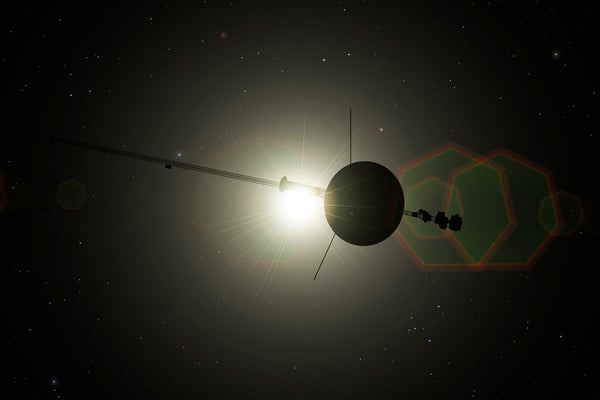
An artist's concept of NASA's Voyager 1, the space agency's venerable and farthest-flung interplanetary probe.
Mark Garlick/Science Photo Library
In the fall of last year, one of NASA’s most venerable spacecraft started beaming home nonsense. Its usual string of 1’s and 0’s—binary code that collectively told of its journey into the unknown—became suddenly unintelligible.
Some 15 billion miles from Earth, beyond the protective bubble blown by the sun and in interstellar space, Voyager 1 was in trouble.
“We’d gone from having a conversation with Voyager, with the 1’s and 0’s containing science data, to just a dial tone,” says Linda Spilker , Voyager project scientist at NASA’s Jet Propulsion Laboratory (JPL).
On supporting science journalism
If you're enjoying this article, consider supporting our award-winning journalism by subscribing . By purchasing a subscription you are helping to ensure the future of impactful stories about the discoveries and ideas shaping our world today.
Spilker joined JPL in 1977, the same year that NASA launched Voyager 1 and its twin, Voyager 2 , on what, in a way, was an endless odyssey: from Earth, to the outer solar system and ultimately to interstellar infinity . Today there are several billion people on Earth who have never taken a breath without the Voyagers in our sky, people who, like me, have only ever existed in a cosmos shared with these talkative twin spacecraft. But like people, spacecraft get old. They break down .
And all good things—and even great ones—must come to an end. After days, and weeks and then months of nothing but indecipherable binary babbling, Voyager 1’s earthbound stewards had to reckon with the idea that maybe, after more than 46 years, its time had at last run out.
The Voyager 1 team at JPL had traced the problem to the spacecraft’s Flight Data System, an onboard computer that parses and parcels engineering and science measurements for subsequent radio transmittal to Earth. One possibility was that a high-energy cosmic particle had struck Voyager 1 and caused a bit flip within the system’s memory — something that has happened more frequently as the craft navigates the hostile wilds of interstellar space. Normally, the team would simply ask the spacecraft for a memory readout, allowing its members to find and reset the errant bit.
“We’ve recovered from bit flips before. The problem this time is we don’t know where the bit flip is because we can’t see what the memory is,” says Suzanne Dodd , Voyager project manager at JPL, who, like Spilker, began her long career with work on the probes. “It’s the most serious issue we’ve had since I’ve been the project manager, and it’s scary because you lose communication with the spacecraft.”
Yesterday, the team announced a significant step in breaking through to Voyager 1. After months of stress and unsuccessful answers they have managed to decode at least a portion of the spacecraft’s gobbledygook, allowing them to (maybe) find a way to see what it has been trying to say.
“It’s an excellent development on Voyager,” says Joe Westlake , director of NASA’s heliophysics division, which oversees the mission.
In the time it will take you to read this story, Voyager 1 will have traversed approximately 10,000 miles of mostly empty space ; in the weeks it took me to report it, the probe traveled some 26 million miles. And since its communication first became garbled last November, the spacecraft has sailed another 10 light-minutes away from home. Voyager 1 and its twin are slipping away from us as surely as the passage of time itself. Sooner or later, these hallowed space-age icons will fall silent, becoming no more than distant memories.
And even among the space community, which of course loves all of its robotic explorers equally, the Voyagers are special. “They are incredibly important and much beloved spacecraft,” says Nicola Fox , NASA’s associate administrator for science. “Voyager 1 is a national treasure, along with Voyager 2 .”
As envisioned, the Voyager mission would exploit a once-in-175-year alignment of Jupiter, Saturn, Uranus and Neptune to slingshot through the solar system’s sparsely charted hinterlands. Legend has it that NASA’s administrator sold the project to President Richard Nixon by noting that the last time the planets were so favorably arranged, Thomas Jefferson was living in the White House. Outfitted with nuclear power sources, the Voyagers were built to last—in utter defiance of the adage that what must go up, must come down. Neither was ever intended to make planetfall again; instead they were bound for the stars. And now, nearly a half-century later, the pair have become the longest-lived and farthest-flung probes ever dispatched by humankind. (Voyager 1 is the front-runner, with its sibling trailing close behind.)
Spilker was straight out of college when she started working on the Voyagers, eager to see the outer solar system through their robotic eyes as they surfed the rare celestial alignment. “I had a telescope in third grade that I used to look at Jupiter and Saturn,” she says. “I wanted to get up really close and get a look at what these planets look like.”
Between 1979 and 1981, Voyager 1 and Voyager 2 zipped by the gas giants , returning stunning images of banded Jupiter and buttery Saturn and their bewildering collection of moons. Voyager 2 went on to scrutinize the ice giants: Uranus in 1986 and Neptune in 1989. These were the first and only times anyone had seen each of these bluish ringed worlds up close.
“They were small little pinpoints of light, and now you’re flying close,” Spilker says. “And you see the cliffs of Miranda”—a bizarre Uranian moon—“and Triton, with active geysers going off.” (Nobody had expected to see an active icy world in orbit around Neptune, and even now Voyager’s 35-year-old image is still the best we have of that strange little moon.)
When the Voyagers left the realm of the known planets, each followed a different path into darkness: Voyager 1 arced up and out of the plane of the solar system, and Voyager 2 looped downward. Spilker also followed her own path: she went to graduate school and earned her doctorate in planetary science using Voyager data—not knowing that several decades later, after leading NASA’s Cassini mission to Saturn, she’d again be part of the mission that started it all.
“The chance came to go back to Voyager,” she says. “And I said, ‘Of course. I’d love to go back.’”
In the interim, as the Voyagers sailed farther from their Earthly harbor, teams shut down many of the onboard instruments, including the cameras. But the pair kept studying the space that they alone were visiting. Their main job was now to characterize the heliosphere—the solar-system-encompassing, cosmic-ray-blocking bubble formed by our sun’s wind and magnetic field. They would document the alien mix of particles and fields that pervade near nothingness. And maybe, if they got lucky, the twins would each escape the protective solar caul entirely to be reborn as true interstellar wanderers.
In 2012 Voyager 1 transcended this boundary , known as the heliopause, where the sun’s influence wanes. Before that scientists could only guess at what lay beyond this barrier and could only model how it shielded Earth from the harshness of the void. Now Voyager 1 could tell us directly about the stuff between the stars. Voyager 2 followed in 2018 , and Fox—then the new chief of NASA’s heliophysics division—was in the midst of the action.
“You’re looking at the cosmic rays going up and the solar wind going down, and it was one of those ‘oh, my god, this is so exciting’ moments,” Fox recalls. “I think of the Voyagers as one mission,” she says. “We’re putting all the data together, but they’re the ones that are out there. They’re the brave spacecraft that have left the protective bubble of the heliosphere and are out exploring interstellar space. It’s hard not to be excited by them.”
This wasn’t the first time Voyager 1 had started speaking an unintelligible language. In 2022, when the probe suffered an earlier bout of garbled telemetry, JPL engineer Bob Rasmussen was shaken out of retirement. The lab wanted to know if Rasmussen, who’d joined the spacecraft’s systems engineering team in 1975, was willing to have a think about the situation.
“I’d been happily retired for a bit more than a year at that point, with plenty else to keep me busy,” Rasmussen says. “But I like solving puzzles, and this was a tough one that I just couldn’t pass up. Cracking it took a few months, but the puzzle stream hasn’t slowed since then.”
Afterward, he stayed on-call. So last November, when Voyager 1 again started transmitting nonsense, Rasmussen was ready for more problem-solving. He was joined by a hand-picked team of specialists, and together they dove into the details for getting the ailing spacecraft back in action.
The problems were at least three layers deep. First, it takes a long time to communicate with Voyager 1. Traveling at the speed of light, the radio signals used to command the spacecraft take 22.5 hours to travel 15 billion miles—and 22.5 hours to come back. Second, the Voyagers are not exactly modern technology.
“Most things don’t last 46 years. Your clock radio and toaster aren’t going to last 46 years,” says Dodd, who started on the Voyager project straight out of school, then worked on other missions and is now back on this one.
Plus, many of the people who built and developed the spacecraft in the 1970s aren’t around to explain the rationale behind the designs.
And third, unluckily enough, whatever had mangled the spacecraft had managed to take out Voyager 1’s ability to send meaningful communications. The team was in the dark, trying to find the invisible source of an error. (Imagine trying to revive a stalled desktop computer with a frozen screen: you can’t see your cursor, and your clicks risk causing more problems—except in this case each input carries a multiday lag and could damage a precious, misbehaving artifact that is more than 15 billion miles away.) Perhaps the most vexing part was the team’s knowledge that Voyager 1 was otherwise intact and functioning as it should be.
“It’s still doing what it’s supposed to be doing,” Westlake says. “It just can’t quite figure out how to send the correct message home.”
Rasmussen and his colleagues set out to understand the spacecraft in as much detail as possible. That meant poring over the original design schematics, now yellowed and pinned to various walls—an effort that resembled “a bit of an archaeology dig,” Dodd says—and studying how past teams had addressed anomalies. That was tricky, Dodd says, because even though the team members could figure out how engineers solved a problem, they couldn’t necessarily discern the rationale behind various solutions. They’d send commands to Voyager 1 about once a week—usually on Fridays—and by Sunday, they’d hear back from the spacecraft.
“There’s suspense after each cautious move, hope with each piece that falls into place, disappointment if our hunches are wrong,” Rasmussen says.
Progress was slow. And as time crept on, the team grew more concerned. But no one was giving up, at any level of leadership.
“I will rely on the Voyager team to say, ‘Hey, Nicky, we’ve done everything , ’” Fox says. “We wouldn’t make any decisions until we knew that every single thing had been tried and tried again because we really do want to get Voyager 1 back talking to us.”
And then, in early March, something changed. In response to a command, instead of beaming back absolute gibberish, the spacecraft sent a string of numbers that looked more familiar. It proved to be a Rosetta stone moment. Soon an unnamed engineer at NASA’s Deep Space Network—the globe-girdling array of radio dishes that relays information from Earth to spacecraft—had learned how to speak Voyager 1’s jumbled language.
After translating that vaguely familiar portion of the spacecraft’s transmission, the team could see that it contained a readout of the flight data system’s memory. Now they face new questions: Can they find and correct the source of the mutated code? Can they learn whether the spacecraft is sending useful science data? Can they restore Voyager 1’s lexicon to its original state—or will they need to continue speaking in the probe’s new postheliopause patois? “The hope is that we’ll get good science data back,” Westlake says. “Thinking about something that’s been a constant throughout my entire career going away is really tough to think about.”
But either by glitch or time’s slow decay of radioactive power sources, the Voyagers will, of course, eventually fade away. Each year they lose four watts of power, and they grow ever colder. “Whether it’s this particular anomaly that gets us or one downstream, or the spacecraft gets old enough and cold enough —one day you’ll go to look for it and it has just stopped working,” Spilker says.
Like silent ambassadors or wordless emissaries, the Voyagers will keep sailing outward, still carrying us with them into the stars—“sort of like a message a bottle,” Spilker says.
Besides their science payloads, a fraction of each spacecraft’s mass was devoted to casting a cosmic message into the interstellar ocean from a lonely island called Earth. Mounted to each probe is a golden record etched with grooves encoding a selection of sights and sounds from our small corner of space and time. An accompanying stylus is positioned to play the record from the beginning, alongside a pictographic and arithmetic instruction manual.
The records are gold because gold is stable for eons, and they’re records because that was the best way to store a lot of information in the 1970s. Should they ever be recovered and decoded, the message will tell the stories of we humans—at least as envisioned (and in some cases performed) by a small group of folks that included my parents ( the late astrophysicist Frank Drake and his surviving spouse Amahl Shakhashiri Drake), astronomer Carl Sagan, documentary producer Ann Druyan and science writer Timothy Ferris. Those stories are imperfect. They’re filled with lopsided optimism and scrubbed of references to war, famine, poverty and most any other Earthly failing—a deliberate decision to hide the defects of our broken world. I know this because my dad, the record’s technical director and a pioneer in the scientific quest to find cosmic civilizations, told me about the hard choices he’d made in selecting the photographs. And I know it because my mom, who recorded the message’s Arabic greeting (“Greetings to our friends in the stars. We wish that we will meet you someday”), helped, too.
For me, as the Voyagers travel through space , they’re not only helping us understand the cosmic context in which we exist; they’re also bearing a memento of my parents into the stars. These spacecraft—and their gleaming paean to Earth—will survive for billions of years. Long after our world, our sun and everything we hold dear becomes unrecognizable, the Voyagers will remain, resolutely speeding ever farther from a home that no longer exists and containing artifacts of a civilization that once was.
That’s why, over nearly half a century, the Voyagers and their interstellar tidings have come to be bigger than the already audacious mission they were designed to accomplish. Their reach is broader. And their inevitable silence will be profound.
“The thought that they’re out there on their own and you can no longer communicate with them—it’s traumatic,” Fox says. “It’s sad. It’s really sad.”
Voyager 1 Now Most Distant Human-Made Object in Space

In a dark, cold, vacant neighborhood near the very edge of our solar system, the Voyager 1 spacecraft is set to break another record and become the explorer that has traveled farthest from home.
At approximately 2:10 p.m. Pacific time on February 17, 1998, Voyager 1, launched more than two decades ago, will cruise beyond the Pioneer 10 spacecraft and become the most distant human-created object in space at 10.4 billion kilometers (6.5 billion miles.) The two are headed in almost opposite directions away from the Sun. As with other spacecraft traveling past the orbit of Mars, both Voyager and Pioneer derive their electrical power from onboard nuclear batteries.
"For 25 years, the Pioneer 10 spacecraft led the way, pressing the frontiers of exploration, and now the baton is being passed from Pioneer 10 to Voyager 1 to continue exploring where no one has gone before," said Dr. Edward C. Stone, Voyager project scientist and director of NASA's Jet Propulsion Laboratory.
"At almost 70 times farther from the Sun than the Earth, Voyager 1 is at the very edge of the Solar System. The Sun there is only 1/5,000th as bright as here on Earth -- so it is extremely cold and there is very little solar energy to keep the spacecraft warm or to provide electrical power. The reason we can continue to operate at such great distances from the Sun is because we have radioisotope thermal electric generators (RTGs) on the spacecraft that create electricity and keep the spacecraft operating," Stone said. "The fact that the spacecraft is still returning data is a remarkable technical achievement."
Voyager 1 was launched from Cape Canaveral on September 5, 1977. The spacecraft encountered Jupiter on March 5, 1979, and Saturn on November 12, 1980.
Then, because its trajectory was designed to fly close to Saturn's large moon Titan, Voyager 1's path was bent northward by Saturn's gravity, sending the spacecraft out of the ecliptic plane - the plane in which all the planets except Pluto orbit the Sun.
Launched on March 2, 1972, the Pioneer 10 mission officially ended on March 31, 1997. However NASA's Ames Research Center, Moffet Field, CA, intermittently receives science data from Pioneer as part of a training program for flight controllers of the Lunar Prospector spacecraft now orbiting the Moon.
"The Voyager mission today presents an unequaled technical challenge. The spacecraft are now so far from home that it takes nine hours and 36 minutes for a radio signal traveling at the speed of light to reach Earth,"said Ed B. Massey, project manager for the Voyager Interstellar Mission. "That signal, produced by a 20 watt radio transmitter, is so faint that the amount of power reaching our antennas is 20 billion times smaller than the power of a digital watch battery,"
Having completed their planetary explorations, Voyager 1 and its twin, Voyager 2, are studying the environment of space in the outer solar system. Although beyond the orbits of all the planets, the spacecraft still are well within the boundary of the Sun's magnetic field, called the heliosphere. Science instruments on both spacecraft sense signals that scientists believe are coming from the outermost edge of the heliosphere, known as the heliopause.
The heliosphere results from the Sun emitting a steady flow of electrically charged particles called the solar wind. As the solar wind expands supersonically into space in all directions, it creates a magnetized bubble -- the heliosphere -- around the Sun. Eventually, the solar wind encounters the electrically charged particles and magnetic field in the interstellar gas. In this zone the solar wind abruptly slows down from supersonic to subsonic speed, creating a termination shock. Before the spacecraft travel beyond the heliopause into interstellar space, they will pass through this termination shock.
"The data coming back from Voyager now suggest that we may pass through the termination shock in the next three to five years," Stone said. "If that's the case, then one would expect that within 10 years or so we would actually be very close to penetrating the heliopause itself and entering into interstellar space for the first time."
Reaching the termination shock and heliopause will be major milestones for the mission because no spacecraft have been there before and the Voyagers will gather the first direct evidence of their structure. Encountering the termination shock and heliopause has been a long-sought goal for many space physicists, and exactly where these two boundaries are located and what they are like still remains a mystery.
Science data are returned to Earth in real-time to the 34- meter Deep Space Network (DSN) antennas located in California, Australia and Spain. Both spacecraft have enough electricity and attitude control propellant to continue operating until about 2020, when electrical power produced by the RTGs will no longer support science instrument operation. At that time, Voyager 1 will be almost 150 times farther from the Sun than the Earth -- more than 20 billion kilometers (almost 14 billion miles) away.
On Feb. 17, Voyager 1 will be 10.4 billion kilometers (6.5 billion miles) from Earth and is departing the Solar System at a speed of 17.4 kilometers per second (39,000 miles per hour). At the same time, Voyager 2 will be 8.1 billion kilometers (5.1 billion miles) from Earth and is departing the solar system at a speed of 15.9 kilometers per second (35,000 miles per hour).
JPL, a division of the California Institute of Technology, manages the Voyager Interstellar Mission for NASA's Office of Space Science, Washington, D. C.
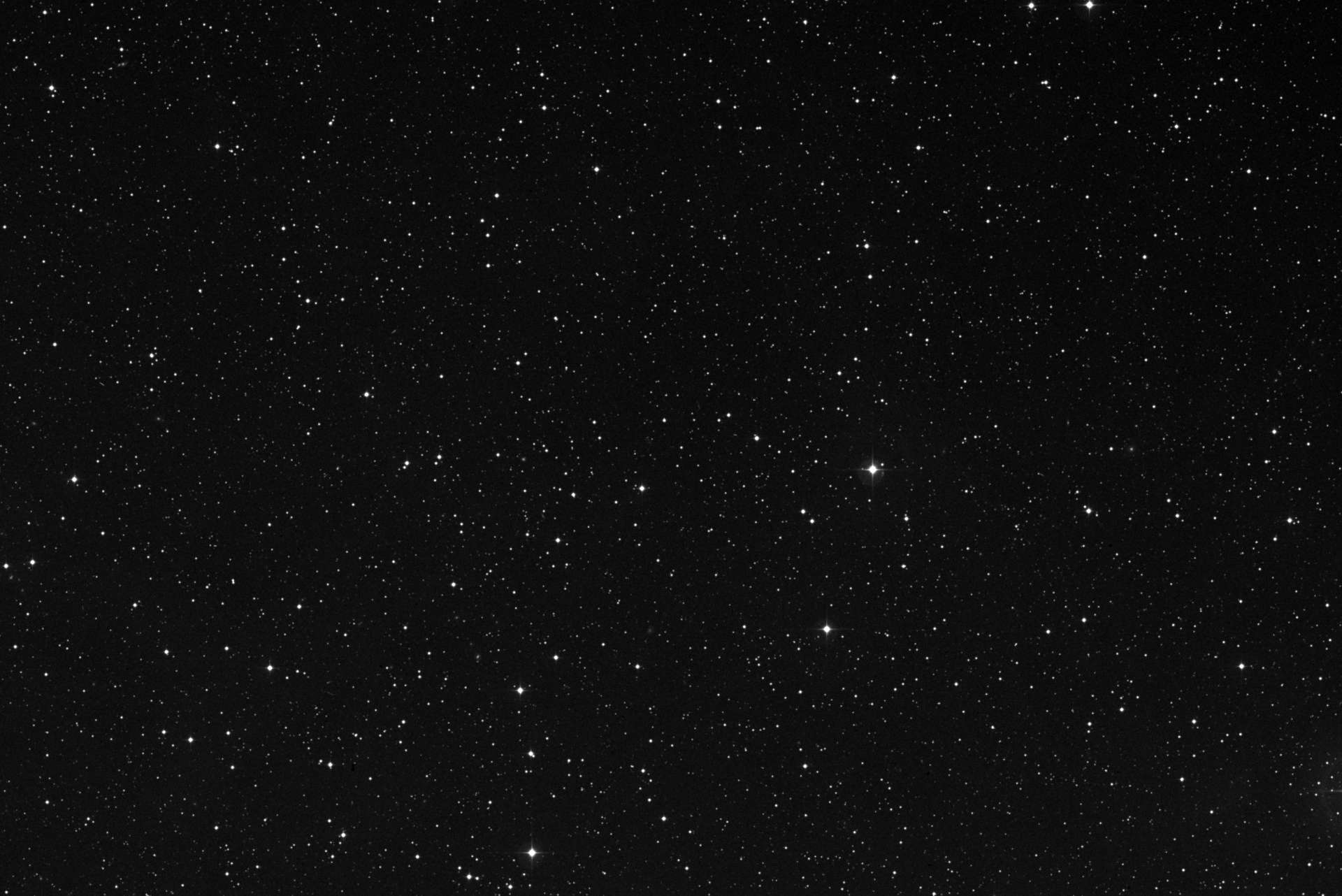
- Object Information
- Planetarium

Voyager 1 live position and data
This page shows Voyager 1 location and other relevant astronomical data in real time. The celestial coordinates, magnitude, distances and speed are updated in real time and are computed using high quality data sets provided by the JPL Horizons ephemeris service (see acknowledgements for details). The sky map shown in the background represents a rectangular portion of the sky 60x40 arcminutes wide. By comparison the diameter of the full Moon is about 30 arcmins, so the full horizontal extent of the map is approximately 2 full Moons wide. Depending on the device you are using, the map can be dragged horizondally or vertically using the mouse or touchscreen. The deep sky image in the background is provided by the Digitized Sky Survey ( acknowledgements ).
Current close conjunctions
List of bright objects (stars brighter than magnitude 9.0 and galaxies brighter than magmitude 14.0) close to Voyager 1 (less than 1.5 degrees):
Additional resources
- 15 Days Ephemerides
- Interactive Sky Map (Planetarium)
- Rise & Set Times
- Distance from Earth
Astronomy databases
- The Digitized Sky Survey, a photographic survey of the whole sky created using images from different telescopes, including the Oschin Schmidt Telescope on Palomar Mountain
- The Hipparcos Star Catalogue, containing more than 100.000 bright stars
- The PGC 2003 Catalogue, containing information about 1 million galaxies
- The GSC 2.3 Catalogue, containing information about more than 2 billion stars and galaxies
The most distant spacecraft in the solar system — Where are they now?
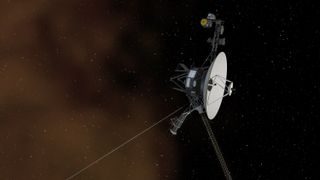
Humans have been flinging things into deep space for 50 years now, since the 1972 launch of Pioneer 10. We now have five spacecraft that have either reached the edges of our solar system or are fast approaching it: Pioneer 10, Pioneer 11, Voyager 1, Voyager 2 and New Horizons.
Most of these probes have defied their expected deaths and are still operating long beyond their original mission plans. These spacecraft were originally planned to explore our neighboring planets, but now they're blazing a trail out of the solar system , providing astronomers with unique vantage points in space — and they've been up to a lot in 2022.
Voyagers 1 and 2
The Voyager missions celebrated a very special anniversary this year: 45 years of operations . From close fly-bys of the outer planets to exploring humans' furthest reach in space, these two spacecraft have contributed immensely to astronomers' understanding of the solar system.
Related : Voyager: 15 incredible images of our solar system captured by the twin probes (gallery)
Their main project now is exploring where the sun 's influence ends, and other stars' influences begin. Voyager 1 crossed the heliopause, the boundary where the sun's flow of particles ceases to be the most important influence, in 2012 with Voyager 2 following close after, in 2018.
"Voyager 1 has now been in interstellar space for a decade…and it's still going, still going strong," Linda Spilker, Voyager project scientist and a planetary scientist at NASA's Jet Propulsion Laboratory (JPL) in California, told Space.com.
The mission team hit one major hiccup this year, when the spacecraft began sending home garbled information about its location. The engineers found the cause — the spacecraft was using a bad piece of computer hardware when it shouldn't have — and restored operations.
Get the Space.com Newsletter
Breaking space news, the latest updates on rocket launches, skywatching events and more!
These kinds of incidents are to be expected with an aging spacecraft, though. The team is also actively managing the power supply onboard each spacecraft, which is dwindling each year as the probes' radioactive generators grow increasingly inefficient. This year, mission personnel turned off heaters keeping a number of scientific instruments on board warm in the harsh, cold environment of space — and, much to everyone's surprise, those instruments are still working perfectly well.
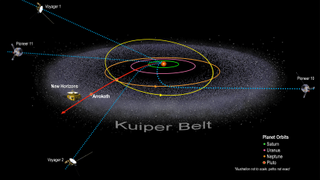
The cameras may have been turned off decades ago, but the spacecrafts' other instruments are collecting data on the plasma and magnetic fields from the sun at a great distance away from the star itself. Because particles of the solar wind — the constant stream of charged particles flowing off the sun — take time to travel such a long way, distant observations allow scientists to see how changes from the sun propagate throughout our cosmic neighborhood.
The edges of the solar system have been full of surprises, too. It would make sense that plasma from the sun becomes more sparse and spread out as you move away from the center of the solar system, but in fact, the Voyagers have encountered much denser plasma after crossing the heliopause. Astronomers are still puzzled about that one.
"It's just so amazing that even after all this time we continue to see the sun's influence in interstellar space," Spilker said. "I'm looking forward to Voyager continuing to operate, perhaps reaching the 50th anniversary."
Pioneers 10 and 11
The Pioneer spacecraft hold a special place in space history because of their role as, you guessed it, pioneers. Unfortunately, these milestone 50-year-old spacecraft are non-functional — Pioneer 10 lost communications back in 2003, and Pioneer 11 has been silent since its last contact in 1995.
But both these spacecraft are marks of humanity's presence in the solar system, and they are still continuing on their journeys, even if we're not sending them commands or firing their rockets anymore. Once a spacecraft is set on a trajectory out of the solar system, according to the laws of physics, it won't stop unless something changes its course.
New Horizons
New Horizons is by far the youngest sibling of these groundbreaking missions, having just launched in 2006 . After completing its famous flyby of dwarf planet Pluto in 2015 , this probe has been zooming out of the solar system at record speed, set to reach the heliopause around 2040.
Not only has it completed its primary mission, but it successfully completed a flyby of the smaller Kuiper Belt object, Arrokoth , in 2019 as its first mission extension. Earlier this year, the spacecraft was put into hibernation mode because an extended mission hadn't yet been approved. But now, the team is excitedly moving into New Horizons' 2nd Kuiper Belt Extended Mission, or KEM2 for short. KEM2 began on Oct. 1 , although the spacecraft will hibernate until March 1, 2023.
In the meantime, the mission team is preparing for exciting new observations. With cutting-edge instruments — far more advanced than what the Voyagers carried in the 1970s — the team is prepared to use New Horizons as a powerhouse observatory in the distant solar system, providing a viewpoint we can't achieve here on Earth .
Bonnie Burrati, planetary scientist at JPL and member of the New Horizons team, is particularly looking forward to new views of Kuiper Belt objects (KBOs), the chunks of ice and rock beyond Neptune . New Horizons' unique position in the outer solar system provides new angles of looking at these KBOs, she said. Different views can tell astronomers about how rough the objects' surfaces are, among other things, based on how light scatters and creates shadows on them.
Another planetary scientist on the team from Southwest Research Institute in Colorado, Leslie Young, wants to use the spacecraft for a new look at something closer to home: the ice giants, Uranus and Neptune. New Horizons’ unique viewpoint provides scientists with information about how light scatters through the planets’ atmospheres—information we can’t get from here on Earth, since we can’t see Uranus and Neptune from that angle. Planetary scientists are eager for more information about these planets, especially as NASA begins planning for a new mission to visit Uranus.
— The icy 'space snowman' Arrokoth in deep space just got names for its best features — Pale Blue Dot at 30: Voyager 1's iconic photo of Earth from space reveals our place in the universe — Destination Pluto: NASA's New Horizons mission in pictures
When the spacecraft wakes from hibernation, it will be past the so-called "Kuiper cliff," where scientists currently think there are far fewer large KBOs. "When we look at other star systems, we see debris disks extending to much larger distances from their host stars," Bryan Holler, an astronomer at Baltimore's Space Telescope Science Institute, told Space.com. "If ET were to look at our solar system, would they see the same thing?"
This next extended mission will even venture beyond New Horizons' original domain of planetary science. Now, the spacecraft will provide better-than-ever measurements of the background of light and cosmic rays in space, trace the distributions of dust throughout our solar system, and obtain crucial information on the sun's influence, complimentary to the Voyagers. Since the three functional far out spacecraft are heading in separate directions, they allow astronomers to map out irregularities in the solar system's structure.
Luckily for New Horizons, signs indicate that the spacecraft will have enough power to last through the 2040s and possibly beyond — each year, moving 300 million miles (480 million kilometers) farther into uncharted territory.
Follow the author at @ briles_34 on Twitter. Follow us on Twitter @ Spacedotcom and on Facebook .
Join our Space Forums to keep talking space on the latest missions, night sky and more! And if you have a news tip, correction or comment, let us know at: [email protected].

Briley Lewis (she/her) is a freelance science writer and Ph.D. Candidate/NSF Fellow at the University of California, Los Angeles studying Astronomy & Astrophysics. Follow her on Twitter @briles_34 or visit her website www.briley-lewis.com .
NASA gets $25.4 billion in White House's 2025 budget request
'Interstellar meteor' vibrations actually caused by a truck, study suggests
We asked over 50 women space leaders for words of inspiration. Here's what they told us
- bolide I wonder if the JWST could see any of these satellites, if it aimed in their direction. Reply
bolide said: I wonder if the JWST could see any of these satellites, if it aimed in their direction.
- View All 2 Comments
Most Popular
By Stefanie Waldek March 29, 2024
By Harry Baker March 29, 2024
By Sharmila Kuthunur March 29, 2024
By Samantha Mathewson March 29, 2024
By Keith Cooper March 29, 2024
By Joe Rao March 29, 2024
By Elizabeth Howell March 29, 2024
By Sharmila Kuthunur March 28, 2024
By Mike Wall March 28, 2024
- 2 Dune: What the climate of Arrakis can tell us about the hunt for habitable exoplanets
- 3 This Week In Space podcast: Episode 104 — The Artemis Accords, Ecuador, and You
- 4 April 8 total solar eclipse: Why this eclipse repeats itself every 54 years
- 5 Spaceflight tripleheader! SpaceX planning 3 launches in 5-hour span today

14.6 billion miles away, NASA gets Voyager 1 talking again — and discovers a new mystery
That’s some repair job.
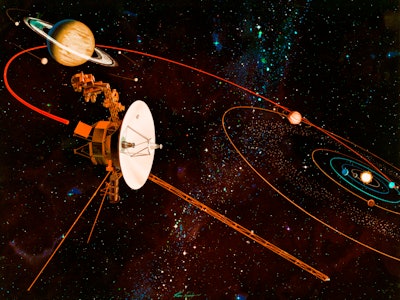
NASA’s Voyager 1 is on a fraught and unknowable journey into deep space. Some 14.6 billion miles from Earth, it and its sister craft, Voyager 2, are the furthest human-made objects from our planet, having made it beyond the edges of the Solar System and out into the interstellar medium. At such distances, anything can go wrong. Add to that the fact that these are old craft: The Voyagers launched in the 1970s. So when Voyager 1 started to send home weird, garbled nonsense instead of telemetry data in May of this year , NASA engineers might have been forgiven for calling it a day and pouring one out for perhaps the most successful space mission of all time.
But that’s not how NASA works . Instead, they started working on a remote diagnosis and fix for the record-breaking spacecraft. Now, some four months later, they are triumphant. Voyager 1 is back online and communicating perfectly with ground control as if it never happened. In fact, the fix turned out to be relatively simple — or as simple as anything can be with a 22-hour communications lag in each direction and billions of miles of space in between.
What happened to Voyager 1?
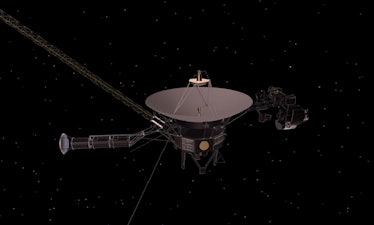
The high-gain antenna, shown on the left in this illustration, is how Voyager 1 sends and receives radio communications with NASA engineers here on Earth.
Cruising in interstellar space, the 45-year-old spacecraft appeared to be operating shockingly well and was transmitting reams of data back to Earth. But in mid-May, Voyager 1’s onboard system responsible for keeping its high-gain antenna pointed at Earth, known as the attitude articulation and control system, or AACS, started beaming home confusing jumbles of data instead of the usual reports about the spacecraft’s health and status. From our viewpoint, it appeared as if the spacecraft had developed something like an electronic version of aphasia — a condition that causes the loss of fluent speech.
“The data may appear to be randomly generated, or does not reflect any possible state the AACS could be in,” explained NASA in a statement from the time.
Even more bafflingly for engineers, Voyager 1 appeared to be in perfect condition despite the spacecraft’s bizarre status reports. The radio signal from the ship remained strong and steady, which meant the antenna was still pointed at Earth — and not in whatever configuration the AACS was claiming it was in to NASA in the reports. Similarly, Voyager 1’s science systems kept gathering and transmitting data as usual, without any of the same strangeness affecting the AACS. And, whatever was wrong with the AACS didn’t trip a fault protection system designed to put the spacecraft in safe mode when there’s a glitch.
Thankfully, NASA engineers diagnosed the problem. And with the diagnosis, they could employ a cure.
The fix — It turned out that the AACS had started sending its telemetry data via an onboard computer that had stopped working years ago. The dead computer corrupted all the outgoing data. All NASA engineers had to do was send the command to the AACS to use the correct computer to send its data home.
But there’s still a problem — The next challenge will be to figure out exactly what caused the AACS to switch computers in the first place. NASA says the system probably received a faulty command from another onboard computer. While they say it is not a major concern for Voyager 1’s well-being right now, the true culprit will need to be found and fixed to prevent future weirdness.
Voyager 1 lives on
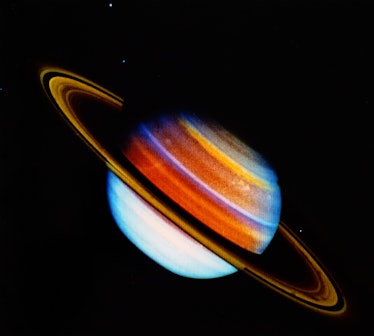
Voyager 1 has yielded revelations about our Solar System no one could have predicted.
Currently, Voyager 1 is more than 23.4 billion kilometers or 14.6 billion miles (and gaining, most of the time ) from Earth. You can watch the distance grow and see both Voyager spacecraft’s current positions in space on NASA’s website .
For the last decade, Voyager 1 has been cruising in interstellar space, beyond the reach of our Sun’s magnetic field. The field had offered the craft a little protection from cosmic rays and other interstellar radiation, much as Earth’s magnetic field offers some protection from high-energy particles and radiation from the Sun. Cosmic rays are known to interfere with electronics here on Earth — when one of those high-speed energetic particles strikes a computer chip, it can cause small memory errors, which add up over time — and it’s reasonable to expect that to be an issue for Voyager 1’s onboard computers, too.
“A mystery like this is sort of par for the course at this stage of the Voyager mission,” said Voyager 1 and 2 project manager Suzanne Dodd in a statement dated to May.
“The spacecraft are both almost 45 years old, which is far beyond what the mission planners anticipated. We’re also in interstellar space — a high-radiation environment that no spacecraft have flown in before.”
We’ll need to wait and see what new perils encounter Voyager next on its travels — and what new discoveries await.
Subscribe for free to Inverse’s award-winning daily newsletter.
This article was originally published on Aug. 31, 2022
- Space Science
Covering the business and politics of space
NASA optimistic about resolving Voyager 1 computer problem

- Click to share on X (Opens in new window)
- Click to share on Facebook (Opens in new window)
- Click to share on LinkedIn (Opens in new window)
- Click to share on Reddit (Opens in new window)
- Click to email a link to a friend (Opens in new window)
- Click to share on Clipboard (Opens in new window)

WASHINGTON — A NASA official says he is optimistic that a problem with the Voyager 1 spacecraft that has kept it from transmitting intelligible data for months can be resolved.
Speaking at a March 20 meeting of the National Academies’ Committee on Solar and Space Physics, Joseph Westlake, director of NASA’s heliophysics division, said it appeared possible to fix the computer problem on the nearly 50-year-old spacecraft that has disrupted operations since last November.
“I feel like we’re on a path now to resolution,” he said. “They’re on the right path and I think we’re going to get to a point where Voyager 1 is going to continue, alive and kicking in space.”
Spacecraft controllers first noticed a problem with the spacecraft in November, when the data transmitted by the spacecraft was unusable. Engineers concluded that the problem was with an onboard computer called the flight data system (FDS), which collects data from the spacecraft’s instruments and other spacecraft telemetry.
Several factors have hampered efforts to correct the problem. Voyager 1, launched in 1977, is now more than 24 billion kilometers from Earth, which means it takes 22.5 hours for signals to travel between Earth and the spacecraft. None of the people who developed the FDS in the early to mid 1970s are available to assist now, so the project has had to turn to documentation to help identify the problem.
NASA announced March 13 progress in fixing the FDS when a command called a “poke” was transmitted to Voyager, and the spacecraft responded by sending back a readout of its memory. The agency said at the time it will compare that readout to one transmitted before the problem to help identify the issue.
Westlake said at the committee meeting that the problem appears to be a corrupted memory unit on the spacecraft. “It’s a part failure on one of the memories and they’re looking for a way to move a couple hundred words of software from one region to another in the flight computer,” he said. A word is two bytes.
He did not estimate how long it would take to make those software changes. NASA, in its latest statement about the spacecraft, said that using the FDS memory readout “to devise a potential solution and attempt to put it into action will take time.”
Jeff Foust writes about space policy, commercial space, and related topics for SpaceNews. He earned a Ph.D. in planetary sciences from the Massachusetts Institute of Technology and a bachelor’s degree with honors in geophysics and planetary science... More by Jeff Foust

Sign up for a SpaceNews newsletter
Get top stories, military space news and more delivered to your inbox.
NASA’s Voyager 1 Is Glitching, Sending Nonsense From Interstellar Space
The aging spacecraft, launched in 1977, is transmitting a gibberish pattern of ones and zeros back to Earth
/https://tf-cmsv2-smithsonianmag-media.s3.amazonaws.com/accounts/headshot/MargaretOsborne.png)
Margaret Osborne
Daily Correspondent
:focal(768x432:769x433)/https://tf-cmsv2-smithsonianmag-media.s3.amazonaws.com/filer_public/13/a4/13a47049-e0ed-4339-b21b-a4026a1a9a4d/voyager-1536x864.png)
NASA’s Voyager 1 probe is experiencing a glitch that’s causing it to send a repeating, gibberish pattern of ones and zeroes back to Earth, the agency announced this week. The spacecraft is still able to receive and execute commands sent to it, but it’s unable to transmit back science or engineering data.
After ruling out other possibilities, the Voyager team determined the spacecraft’s issues stem from one of its three computers, called the flight data system (FDS). Last weekend, engineers tried to restart the FDS to see whether they could resolve the problem, but the probe still isn’t returning usable data, according to NASA.
Launched in 1977, Voyager 1 and its twin spacecraft Voyager 2 are NASA’s longest-operating mission. They are the only probes to ever explore interstellar space , or the vast area between stars. The spacecraft were initially launched to study Jupiter and Saturn, and they were only intended to last five years . But after making a series of discoveries—including spotting active volcanoes on Jupiter’s moon Io—NASA extended their mission. Both spacecraft carry a “ golden record ,” a 12-inch, gold-plated, copper disk that contains sounds and images to represent humankind in case any extraterrestrials ever encounter them.
My twin Voyager 1 is having a bit of trouble with its Flight Data System, but our team is on it! Details from @NASAJPL below. -V2 https://t.co/DRnxCzYLv5 — NASA Voyager (@NASAVoyager) December 12, 2023
By today’s standards, the technology aboard the Voyager crafts is ancient. Their computers only have 69.63 kilobytes of memory —about enough to store an average jpeg file. To make room for new observations, they must erase data after sending it to Earth.
“The Voyager computers have less memory than the key fob that opens your car door,” Linda Spilker , a planetary scientist who started working on the Voyager missions in 1977, told Scientific American ’s Tim Folger last year.
But the simple, yet hardy design of the Voyagers has contributed to their longevity and allowed them to hop between missions to collect valuable data. Still, both aging spacecraft have experienced glitches. Over the summer, a human error caused Voyager 2’s antenna to tilt two degrees away from Earth , leading researchers to lose contact with the craft for more than a week before its functions returned to normal. In 2022, an issue in the attitude articulation and control system (AACS) of Voyager 1 caused it to send “garbled information about its health and activities to mission controllers, despite operating normally,” per NASA . Engineers were eventually able to solve the glitch.
Right now, Voyager 1 is hurtling through space about 15 billion miles from Earth and Voyager 2 is more than 12.6 billion miles away. Because the spacecraft are so distant, commands from mission controllers take 22.5 hours to reach Voyager 1. This means it takes 45 hours to determine whether a command to the spacecraft has had the intended outcome. NASA says it could take several weeks to develop a new plan to fix the current FDS problem.
“Finding solutions to challenges the probes encounter often entails consulting original, decades-old documents written by engineers who didn’t anticipate the issues that are arising today,” NASA says in its statement. “As a result, it takes time for the team to understand how a new command will affect the spacecraft’s operations in order to avoid unintended consequences.”
Calla Cofield, a media relations specialist at NASA’s Jet Propulsion Laboratory, which manages the mission, tells CNN ’s Ashley Strickland engineers are now working to find the underlying cause of the problem before figuring out next steps.
“The Voyagers are performing far, far past their prime missions and longer than any other spacecraft in history,” Cofield tells the publication. “So, while the engineering team is working hard to keep them alive, we also fully expect issues to arise.”
Get the latest stories in your inbox every weekday.
/https://tf-cmsv2-smithsonianmag-media.s3.amazonaws.com/accounts/headshot/MargaretOsborne.png)
Margaret Osborne | | READ MORE
Margaret Osborne is a freelance journalist based in the southwestern U.S. Her work has appeared in the Sag Harbor Express and has aired on WSHU Public Radio.

Voyager 1's Communication Malfunctions May Show the Spacecraft's Age
A s it turns out, spacecraft aren't immune to age. In November 2023, NASA's 46-year-old Voyager 1 spacecraft started sending a stream of nonsense to Earth, spewing out signals without any morsel of meaning . Members of the Voyager 1 mission team are rushing to resolve the issue in the aging spacecraft and are relatively optimistic after receiving a more meaningful response from the spacecraft this month.
But the ongoing breakdown in communication casts doubts on the durability of the probe and about why its systems are so prone to problems - a product, it seems, of the passage of time.
Read More: The Best of Voyager: The Longest-Running Space Mission in History
What Went Wrong with Voyager 1?
Sent into space in 1977 as part of NASA's Voyager mission , the Voyager 1 spacecraft has traveled more than 15 billion miles through space. Throughout its travels, the spacecraft has collected information about its surroundings and its status while drifting deeper and deeper into the universe, compiling insights on the outer solar system and the space beyond the outer solar system alongside its twin, the Voyager 2 spacecraft .
The probe has had its fair share of bugs throughout the course of its trip, with one of its biggest blips beginning in November. Though the spacecraft continues to receive and respect the commands of the Voyager 1 mission team, its communication system started to fail at around that time, meaning the spacecraft cannot send meaningful signals of its own. Instead, it's stuck returning a repeating sequence of ones and zeros, rather than its typical output of important insights condensed in convenient bundles of binary code.
As of now, the problem seems to persist, interrupting Voyager 1's interstellar investigation. But this isn't the only problem that's troubled the probe. In fact, after almost fifty years of flight, Voyager 1 is increasingly showing signs of its age.
Read More: Voyager: The Man Behind the Mission
Why Is Voyager 1 Prone to Problems?
Initially intended to study Jupiter and Saturn , Voyager 1 and Voyager 2 were built to survive only five years of flight. But as their flybys of the two planets came to a close and as their trajectories forged further and further into space, it seemed a shame to cut their travels short. In time, their two-planet mission transformed into a four-planet mission, and their four-planet mission transformed into an interstellar mission, as the probes became the first spacecraft to shoot into the space between stars, in 2012 and 2018 respectively.
Since then, though, Voyager 1's smooth sailing has become bumpier and bumpier, possibly a product of age. In 2017, for instance, the probe's primary thrusters started to struggle, pushing the Voyager 1 team to switch to its secondary thrusters to maintain its ability to align itself for communication. And in 2022, Voyager 1's attitude articulation and control system (AACS) met with a malfunction of its own, reducing the spacecraft's messages to meaningless nonsense , a lot like the issue that started in November.
Aside from these issues, it's the diminishing power supplies of the aging spacecraft that pose the biggest problems: As their power diminishes, scientists are slowly switching off some of their scientific instruments in an attempt to save others. It's a strategic move, as mission team members attempt to get as much information out of the probes as possible, though issues, including the ongoing Voyager 1 glitch, only get in the way of that goal.
Read More: Voyager: What's Next for NASA's Interstellar Probes?
What Will Fix Voyager 1?
Identifying the issue in the spacecraft's computers, the Voyager 1 mission team concluded that the current conundrum arose from a " corrupted section " in the software of one of Voyager 1's communication systems, called the flight data subsystem (FDS). This subsystem bundles the information collected by the probe before it is beamed back to the mission team.
In December, the mission team restarted the FDS, though the restart failed to return the subsystem to its functional state. In the aftermath of the attempt, the team then decided to send a command called a " poke " to the probe on March 1. The poke was cautiously considered and planned to push the corrupted subsystem to work around its corruption.
A response was received on March 3, not nonsense, but still difficult to discern. The delay in the response was anticipated - it takes 22.5 hours for signals to reach the probe and another 22.5 hours for signals to reach the mission team - but the response was cryptic. It wasn't until March 10 that the mission team members determined the response carried a readout of the FDS memory, including its initial instructions as well as its altered code, whether altered by command or by the status of the spacecraft.
By comparing the readout to those received before the issue began, it is possible that the team will identify the source of the problem, as well as its solution. But that " will take time ," according to a NASA press release - a particularly precious resource for the aging probe.
Read More: 5 NASA Spacecraft That Are Leaving Our Solar System for Good
Article Sources
Our writers at Discovermagazine.com use peer-reviewed studies and high quality sources for our articles, and our editors review for scientific accuracy and editorial standards. Review the sources used below for this article:
NASA The Sun Spot. Engineers Working to Resolve Issue With Voyager 1 Computer
NASA. Voyager
NASA. Voyager 1
NASA. Voyager 2
NASA The Sun Spot. NASA Engineers Make Progress Toward Understanding Voyager 1 Issue
NASA Jet Propulsion Laboratory. Voyager - Fact Sheet
NASA Jet Propulsion Laboratory. Voyager - The Interstellar Mission
NASA Jet Propulsion Laboratory. Voyager 1 Fires Up Thrusters After 37 Years
NASA Jet Propulsion Laboratory. Engineers Investigating NASA's Voyager 1 Telemetry Data
NASA Jet Propulsion Laboratory. NASA's Voyager Will Do More Science With New Power Strategy
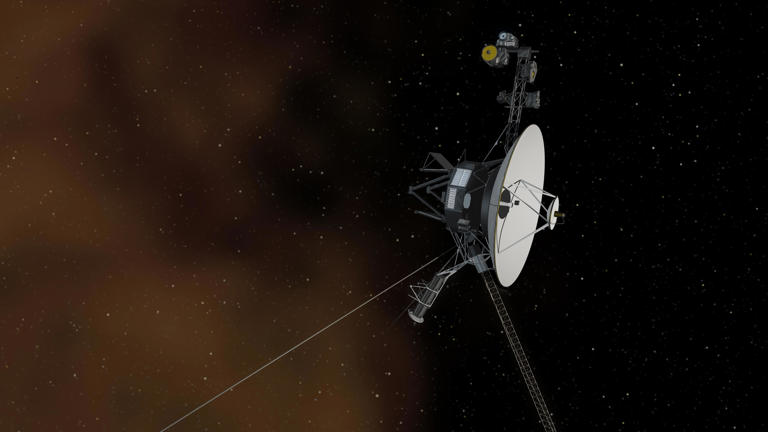
Screen Rant
Star trek: voyager’s seska actor thinks her character’s death was “a mistake”.
Star Trek: Voyager killed Seska off in the season 3 premiere, but actor Martha Hackett felt that the way Seska's death was handled was a mistake.
- Martha Hackett thought Seska's Star Trek: Voyager death was a mistake due to a lack of proper confrontation with Janeway or Chakotay.
- Seska's death was a victim of a failing storyline involving the Kazon in Voyager's plot.
- Seska, a potentially great villain, was underutilized by the show's writers, missing out on her full narrative potential.
Star Trek: Voyager actor Martha Hackett felt that Seska's death at the beginning of season 3 was a mistake. Seska was first introduced in Voyager season 1, episode 3, "Parallax." As a former Maquis and someone who had a romantic history with Commander Chakotay (Robert Beltran), Seska quickly became a recurring member of Star Trek: Voyager 's cast throughout most of season 1, until it was revealed late in the season that she was Cardassian spy within the Maquis and had been stealing and sharing technology with the Kazon since she joined Voyager 's crew.
Seska quickly defected to the Kazon when her deception was discovered, and became a villain for the majority of season 2, working alongside Maje Culluh (Anthony De Longis) to antagonize the USS Voyager. This culminated in the Voyager season 2 finale/season 3 premiere episode, "Basics Parts 1&2" where Seska and the Kazon briefly managed to take over the ship and strand the crew on an alien planet. Luckily, Captain Janeway (Kate Mulgrew) was able to retake Voyager and stop the Kazon for good, but this ultimately came at the cost of a few significant lives, including Seska's.
Every Voyager Character Who Has Returned In Star Trek (& How)
Martha hackett thought that seska’s star trek: voyager death was a mistake, hackett felt that seska's death should have been handled differently.
In an interview with Star Trek Monthly issue 34 (now called Star Trek Magazine ), Martha Hackett outlined her issues with the way that Seska was killed, even going so far as to call the decision a mistake. Hackett's bigger issue with her character's death seemed to be the abrupt way it happened, which gave no time for a final confrontation between her and Captain Janeway or even Chakotay , the two characters she maintained the most antagonism with throughout her run. Read Hackett's full quote below.
"I think it was a mistake to kill Seska. I just felt that if they were going to kill her off, they should have done it in a more fantastic way. It would have been interesting if it had been something that came down to being between Seska and Captain Janeway, or Seska and Chakotay. She was their nemesis, and for her to die in a ship blast seemed like an easy way out. There were other opportunities for a face-off where they couldn't help but kill her off. But that's just me talking. I suppose the writers felt like they were at the end of that storyline."
Seska's death in "Basics Part 2" was dramatic in a sense. Although being felled by a series of overloaded consoles wasn't exactly memorable, Seska's final attempt to reach her newborn baby in Janeway's ready room was legitimately heartbreaking to watch. Still, Hackett's assessment that "Basics" essentially wasted Seska's potential is accurate. Excluding the possibility of a showdown between here and Janeway or Chakotay left a large part of her story feeling unfinished. Unfortunately, Seska was the victim of being caught up in an already failing storyline.
Why Voyager Killed Seska Off At The Beginning Of Season 3
Seska was the victim of being dragged into a dying storyline.
Involving Seska in Voyager 's Kazon storyline sealed her fate from the beginning. Unfortunately, the Kazon were nearly universally hated after their introduction in "Caretaker." Voyager never found a way to make them work, and it was inevitable that their storyline would end not with a bang but with a whimper. If the Kazon had been the only victims of the end of season 2, it would arguably have been a victory for the show, but the storyline had the unfortunate side effect of taking Seska with it.
Seska was objectively a much more interesting nemesis than the Kazon, and a tie-back to a familiar set of Star Trek villains with her Cardassian heritage. Having her join the Kazon after betraying Voyager did make narrative sense, but had she been allowed to function on her own, the possibilities for her story might have been more expansive. If Star Trek: Voyager had given Seska more independence, her death might have ended up being closer to the one Martha Hackett envisioned, instead of an aborted ending where she felt under-utilized.
Source: Star Trek Monthly issue 34
Star Trek: Voyager is available to stream on Paramount+.
Star Trek: Voyager
*Availability in US
Not available
The fifth entry in the Star Trek franchise, Star Trek: Voyager, is a sci-fi series that sees the crew of the USS Voyager on a long journey back to their home after finding themselves stranded at the far ends of the Milky Way Galaxy. Led by Captain Kathryn Janeway, the series follows the crew as they embark through truly uncharted areas of space, with new species, friends, foes, and mysteries to solve as they wrestle with the politics of a crew in a situation they've never faced before.

7 Things to Know About Voyager
Voyager 2 launched on Aug. 20, 1977, from Cape Canaveral, Florida aboard a Titan-Centaur rocket. Voyager 1 launched on Sept. 5 from Cape Canaveral on a similar rocket.
Planetary Tour
Between them, Voyager 1 and 2 explored all the giant planets of our solar system; 48 moons orbiting them; and unique systems of rings and magnetic fields surrounding them.
Most Distant Spacecraft
On Feb. 17, 1998, Voyager 1 passed Pioneer 10 to become the most distant human-made object in space.
The Golden Record
Both Voyager spacecrafts carry a greeting to any form of life, should that be encountered.
Termination Shock
Voyager 1 crossed the termination shock in December 2004 at about 94 AU from the Sun while Voyager 2 crossed it in August 2007 at about 84 AU.
Going Interstellar
Voyager 1, which is traveling up away from the plane of the planets, entered interstellar space on Aug. 25, 2012. Voyager 2, which is headed away from the Sun beneath the plane of the planets, reached interstellar space on Nov. 5, 2018.
Present Status
Voyager 1 is escaping the solar system at a speed of about 3.6 AU per year. Voyager 2 is escaping the solar system at a speed of about 3.3 AU per year.
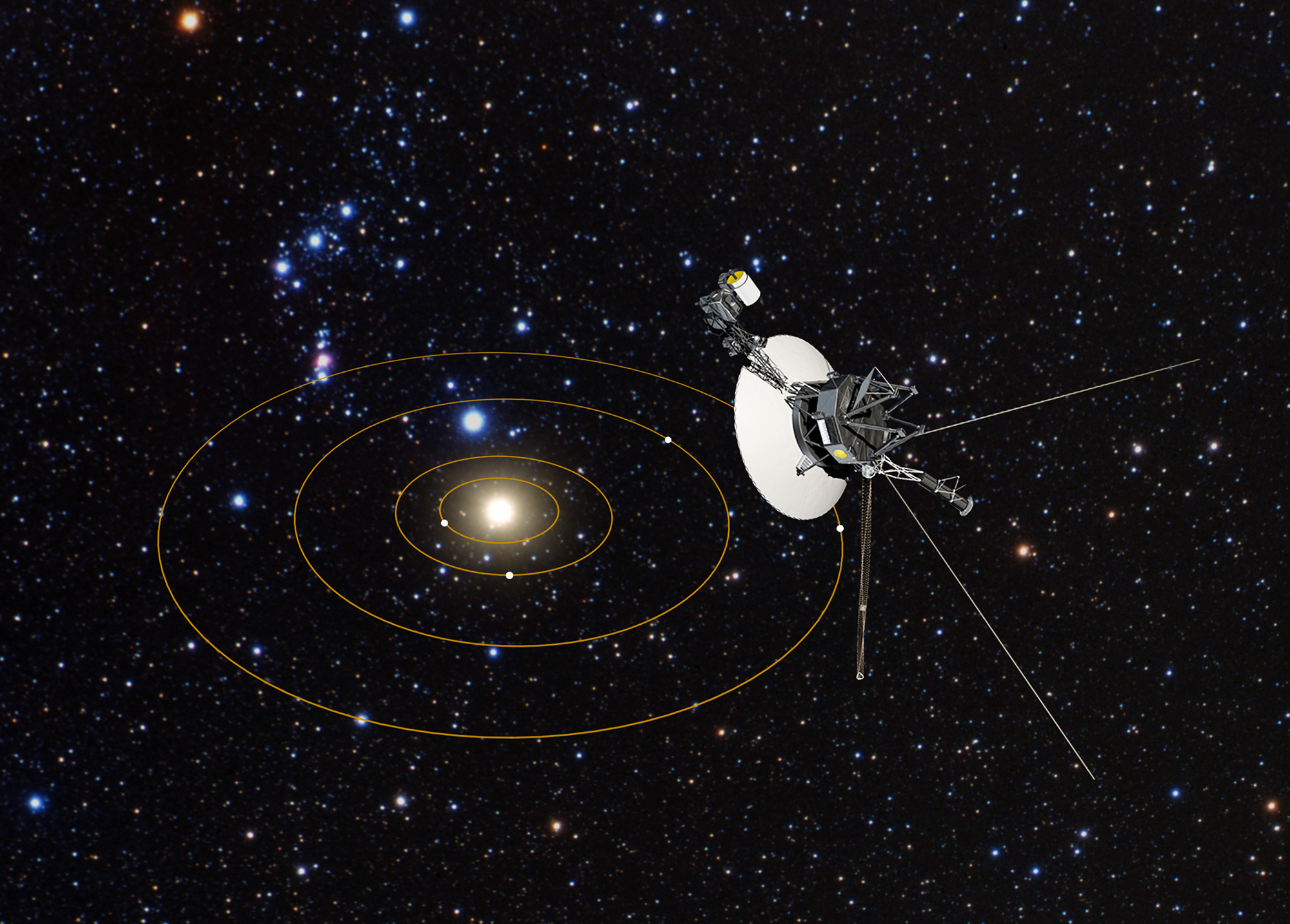

- The Contents
- The Making of
- Where Are They Now
- Frequently Asked Questions
- Q & A with Ed Stone
golden record
Where are they now.
- frequently asked questions
- Q&A with Ed Stone
The Golden Record
Pioneers 10 and 11, which preceded Voyager, both carried small metal plaques identifying their time and place of origin for the benefit of any other spacefarers that might find them in the distant future. With this example before them, NASA placed a more ambitious message aboard Voyager 1 and 2, a kind of time capsule, intended to communicate a story of our world to extraterrestrials. The Voyager message is carried by a phonograph record, a 12-inch gold-plated copper disk containing sounds and images selected to portray the diversity of life and culture on Earth.
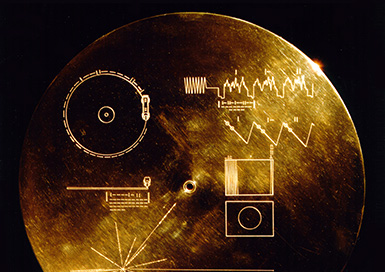

IMAGES
VIDEO
COMMENTS
Both Voyager 1 and Voyager 2 have reached "Interstellar space" and each continue their unique journey through the Universe. In the NASA Eyes on the Solar System app, you can see the real spacecraft trajectories of the Voyagers, which are updated every five minutes. Distance and velocities are updated in real-time.
Voyager 1 is more than 118 AU from the sun, traveling at 17.1 km/s, and within the constellation Ophiuchus. It is expected to encounter the Heliopause, where the solar wind ceases, in 10 to 20 years.
Since late 2023, engineers have been trying to get the Voyager spacecraft back online. On Dec. 12, 2023, NASA shared some worrisome news about Voyager 1, the first probe to walk away from our ...
Now, Voyager 1's voice from the sky has provided engineers with a clue that could help them realize this miracle. reader comments 209. Stephen Clark Stephen Clark is a space reporter at Ars ...
This tells how long it would take a radio signal transmitted right now, traveling at the speed of light, to get either from Earth to Voyager 1 or from Voyager 1 to Earth. ... Data from this instrument suggested that Voyager 1 entered interstellar space on Aug. 25, 2012, when the inside particles (green) dipped closer to 0.0 and the outside ...
Now, it may have bid its final farewell to that faraway dot. Voyager 1, the farthest man-made object in space, hasn't sent coherent data to Earth since November. NASA has been trying to diagnose ...
Voyager 1 is the first spacecraft to enter interstellar space, the region between stars, in 2012. It is still sending scientific data through the Deep Space Network and exploring the outermost edge of the Sun's sphere of influence.
Voyager 1 is a space probe launched by NASA on September 5, ... Voyager 1 ' s trajectory seen from Earth, diverging from the ecliptic in 1981 at Saturn and now heading towards the constellation Ophiuchus: Date Event 1977-09-05 Spacecraft launched at 12:56:00 UTC. 1977-12-10 Entered asteroid belt.
Now Voyager 1 is over 15 billion miles away, beyond what many consider to be the edge of the solar system. Yet the on-board instrument Krimigis is in charge of is still going strong.
"Voyager 1 is likely to return the first direct evidence from the heliopause and what lies beyond it," Stone said. ... Voyager 1 is now 7 billion kilometers (4.3 billion miles) from Earth, traveling at a heliocentric velocity of 63,800 km/hr (39,700 mph). Voyager 2, traveling in the opposite direction from its twin, is 5.3 billion kilometers (3 ...
Now Voyager 1 could tell us directly about the stuff between the stars. Voyager 2 followed in 2018 , and Fox—then the new chief of NASA's heliophysics division—was in the midst of the action.
Voyager 1 broke the record of Pioneer 10 and became the most distant human-made object in space on February 17, 1998. It was launched in 1977 and studied the outer solar system and the heliosphere until 2020.
Voyager 1 is a space probe launched by NASA on September 5, 1977, to study the outer Solar System and beyond. It is currently the most distant human-made object from Earth, having traveled over 14 billion miles (23 billion kilometers) from the Sun. Voyager 1's mission has included flybys of Jupiter and Saturn, with the goal of studying their moons, rings, and magnetic fields.
Voyager 1 live position and data. This page shows Voyager 1 location and other relevant astronomical data in real time. The celestial coordinates, magnitude, distances and speed are updated in real time and are computed using high quality data sets provided by the JPL Horizons ephemeris service (see acknowledgements for details). The sky map shown in the background represents a rectangular ...
Voyager 1 and its twin Voyager 2 are the only spacecraft ever to operate outside the heliosphere, the protective bubble of particles and magnetic fields generated by the Sun. Voyager 1 reached the interstellar boundary in 2012, while Voyager 2 (traveling slower and in a different direction than its twin) reached it in 2018.
We now have five spacecraft that have either reached the edges of our solar system or are fast approaching it: Pioneer 10, Pioneer 11, Voyager 1, Voyager 2 and New Horizons. Most of these probes ...
Voyager 1 has yielded revelations about our Solar System no one could have predicted. Currently, Voyager 1 is more than 23.4 billion kilometers or 14.6 billion miles (and gaining, most of the time ...
Voyager 1's flight data system collects information from the spacecraft's science instruments and bundles it with engineering data that reflects the current health status of Voyager 1.
Voyager 1, launched in 1977, is now more than 24 billion kilometers from Earth, which means it takes 22.5 hours for signals to travel between Earth and the spacecraft.
On Feb. 17, Voyager 1 will be 10.4 billion kilometers (6.5 billion miles) from Earth and is departing the Solar System at a speed of 17.4 kilometers per second (39,000 miles per hour). At the same time, Voyager 2 will be 8.1 billion kilometers (5.1 billion miles) from Earth and is departing the solar system at a speed of 15.9 kilometers per ...
NASA's 46-year-old Voyager 1 spacecraft has experienced a computer glitch that prevents it from returning science data to Earth from the solar system's outer reaches. ... Now playing - Source
Right now, Voyager 1 is hurtling through space about 15 billion miles from Earth and Voyager 2 is more than 12.6 billion miles away. Because the spacecraft are so distant, commands from mission ...
A s it turns out, spacecraft aren't immune to age. In November 2023, NASA's 46-year-old Voyager 1 spacecraft started sending a stream of nonsense to Earth, spewing out signals without any morsel ...
Voyager 1 is now leaving the solar system, rising above the ecliptic plane at an angle of about 35 degrees at a rate of about 520 million kilometers (about 320 million miles) a year. Voyager 2 is also headed out of the solar system, diving below the ecliptic plane at an angle of about 48 degrees and a rate of about 470 million kilometers (about ...
Star Trek: Voyager actor Martha Hackett felt that Seska's death at the beginning of season 3 was a mistake. Seska was first introduced in Voyager season 1, episode 3, "Parallax." As a former Maquis and someone who had a romantic history with Commander Chakotay (Robert Beltran), Seska quickly became a recurring member of Star Trek: Voyager's cast throughout most of season 1, until it was ...
Between them, Voyager 1 and 2 explored all the giant planets of our solar system; 48 moons orbiting them; and unique systems of rings and magnetic fields surrounding them. Explore. 03. Most Distant Spacecraft. On Feb. 17, 1998, Voyager 1 passed Pioneer 10 to become the most distant human-made object in space. 04.
Shares of Voyager Therapeutics, Inc. ( NASDAQ:VYGR - Get Free Report) rose 8.1% during mid-day trading on Monday . The stock traded as high as $10.07 and last traded at $10.06. Approximately 147,419 shares changed hands during trading, a decline of 85% from the average daily volume of 992,340 shares. The stock had previously closed at $9.31.
The Golden Record. Pioneers 10 and 11, which preceded Voyager, both carried small metal plaques identifying their time and place of origin for the benefit of any other spacefarers that might find them in the distant future. With this example before them, NASA placed a more ambitious message aboard Voyager 1 and 2, a kind of time capsule ...